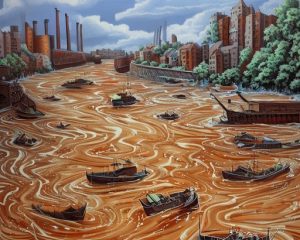File under: ‘It could be worse.’
On a warm January day in 1919, a disaster struck Boston’s North End. A giant tank of molasses burst open, releasing a wave of sticky syrup that swept through the streets, crushing buildings and killing 21 people. The Great Molasses Flood, as it became known, was a bizarre and tragic event. The tank, which belonged to the Purity Distilling Company, was 54 feet high and 98 feet in diameter. It held over two million gallons of molasses, which was used to make rum.
On the day of the flood, the weather was unseasonably warm, this caused the molasses to ferment, which created gas pressure inside the tank. The tank was also poorly constructed, and it eventually gave way under the pressure.
The molasses burst out of the tank with tremendous force, creating a wave that reached 15 feet high and traveled over two blocks. The wave crushed buildings, overturned cars, and swept people away. Many of the victims of the flood were trapped in the molasses. It was thick and sticky, and it was almost impossible to escape. Others were crushed by debris or drowned in the floodwaters.
The cleanup after the flood was a massive undertaking. The molasses was so thick and sticky that it had to be dug up with shovels and steamrollers. It took weeks to remove all of the molasses from the streets and buildings. Until this day walkers by can still smell that that sickly sweet smell of molasses wafting through the neighborhood.
(Mostly) Vegetarian, Politically Progressive, Daily Runner, Spiritual, Helpful, Friendly, Kind, Warm Hearted and Forgiving. Resident of Braintree MA.




I am not aware that the prohibition advocates used this fine example to oppose distilling rum and other liquors. Such a missed opportunity! The result of this flood would be a good description how they were stuck in their own arguments.
Wow Kevin, I had to research this to be sure you weren’t pulling our legs!
It’s awful that people died and I don’t mean to make fun of a tragic situation, but isn’t it ironic that Boston is known for it’s baked beans – a perfect accompaniment for all that molasses!
Great flood example, Kevin. As a Boston transplant (from Detroit), my husband shared this story with me years ago. It almost defies imagination, but of course, is absolutely true! Thank you for writing it up and sharing with those who might not be aware of the story.
Kevin, I lived in Boston and I never heard about the Great Molasses Flood! What a sticky mess that must have been, and I wonder how many rodents and other alley creatures rushed in to feast!
Wow, I never knew about this, even though we had lots of family in Boston and my son lives there now. I’ll have to tell him this story. Of course, 1919 goes back a bit. Maybe my father knew about it but never shared the story with us.
Good for you that you educated so many of our Retrospecters on this important slice of Boston history. I knew about it but did not realize it began in the North End. The man who told me about it (and acted like he was there, although he couldn’t have been) described a “wave of molasses going right up Morrissey Boulevard!” I have always pictured it that way, and kind of had the idea that the molasses tank was about where we see the Sister Corita painting on the big gas tank! I guess that part is totally wrong and not substantiated by the history. Say it ain’t so, Kevin?
The Great Molasses Flood occurred in Boston’s North End nowhere near Dorchester – but I too have smelled the Molasses while walking in the Boston.